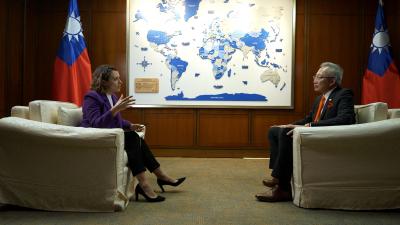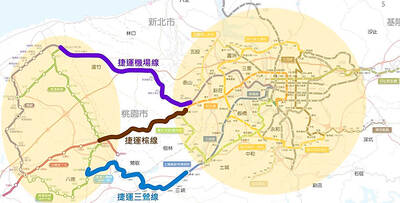The US Air Force sought to attack China with nuclear weapons early on during the Chinese military blockade of Kinmen and Matsu in 1958, but then-US president Dwight D. Eisenhower vetoed the idea, newly declassified Air Force histories released on Wednesday show.
But while Eisenhower rejected the use of the nuclear weapons as a first response to the Chinese actions, he and his top officials did not rule out their use if the crisis went on for an extended period. In that case, “nuclear strikes apparently would follow,” the documents reveal.
Air Force officials advocated hitting targets in the area of Xiamen and other cities, including Shanghai, if the crisis escalated, the documents, released by the National Security Archives, an anti-secrecy research institute located at George Washington University in Washington showed.
As the crisis grew, members of Eisenhower’s Cabinet and military leaders “accepted the idea that the United States would have to resort to nuclear weapons to prevent the Communists from using ships and aircraft to isolate the Nationalist-held islands,” one document said.
The chairman of the Joint Chiefs of Staff, General Nathan Twining, advocated dropping 10 kiloton to 15 kiloton nuclear bombs near what was then known as Amoy, and possibly on “airfields as far distant as Shanghai,” the document says.
While admitting that such acts “might bring down nuclear vengeance” on Taiwan, he “considered this is a risk that would have to be taken if the offshore islands were to be defended,” it says.
Pacific Air Force commander, General Laurence Kuter, was the main proponent of the immediate nuclear option, and was astounded when he found out that Eisenhower rejected it, the history says. Based on his assumption, in mid-August of 1958, five Strategic Air Command B-47s on Guam went on alert “to conduct nuclear raids against mainland airfields,” the document says.
On Aug. 25, at a White House meeting, Eisenhower “rejected the idea of using atomic weapons immediately upon the outbreak of hostilities. Instead, he insisted that the first strikes be made with high explosives, although nuclear weapons would be available if needed for subsequent attacks,” the history shows.
By October, the crisis subsided as China apparently concluded that the massive US response in defense of dictator Chiang Kai-shek (將介石) and his government rendered an all-out attack on the offshore islands not worth the effort, the history suggests.
The 10 formerly secret and top-secret histories of the US Air Force, which contain the history of the 1958 Taiwan crisis, were obtained by the archives under a Freedom of Information Act request initially filed in the 1990s and released only after a recent court action.
An analysis accompanying the Quemoy-Matsu crisis history suggests that the incident had a wider implication for US military strategy, and especially its thoughts on nuclear warfare.
“The assumption that the United States would meet Communist aggression by immediate nuclear retaliation did not survive the Taiwan crisis of 1958,” the document says. “The caution [Eisenhower] displayed at the time ... forced US military planners to review their attitudes concerning nuclear wars.”

“China is preparing to invade Taiwan,” Deputy Minister of Foreign Affairs Francois Wu (吳志中) said in an exclusive interview with British media channel Sky News for a special report titled, “Is Taiwan ready for a Chinese invasion?” the Ministry of Foreign Affairs said today in a statement. The 25-minute-long special report by Helen Ann-Smith released yesterday saw Sky News travel to Penghu, Taoyuan and Taipei to discuss the possibility of a Chinese invasion and how Taiwan is preparing for an attack. The film observed emergency response drills, interviewed baseball fans at the Taipei Dome on their views of US President

The Central Weather Administration (CWA) today issued a "tsunami watch" alert after a magnitude 8.7 earthquake struck off the Kamchatka Peninsula in northeastern Russia earlier in the morning. The quake struck off the east coast of the Kamchatka Peninsula at 7:25am (Taiwan time) at a depth of about 19km, the CWA said, citing figures from the Pacific Tsunami Warning Center. The CWA's Seismological Center said preliminary assessments indicate that a tsunami could reach Taiwan's coastal areas by 1:18pm today. The CWA urged residents along the coast to stay alert and take necessary precautions as waves as high as 1m could hit the southeastern

ECONOMIC BENEFITS: The imports from Belize would replace those from Honduras, whose shrimp exports have dropped 67 percent since cutting ties in 2023 Maintaining ties with Taiwan has economic benefits, Ministry of Foreign Affairs officials said yesterday, citing the approval of frozen whiteleg shrimp imports from Belize by the Food and Drug Administration (FDA) as an example. The FDA on Wednesday approved the tariff-free imports from Belize after the whiteleg shrimp passed the Systematic Inspection of Imported Food, which would continue to boost mutual trade, the ministry said. Taiwan’s annual consumption of whiteleg shrimps stands at 30,000 tonnes, far exceeding domestic production, the ministry said. Taiwan used to fill the gap by importing shrimps from Honduras, but purchases slumped after Tegucigalpa severed diplomatic ties with Taiwan

The Executive Yuan yesterday approved a southwestern extension of the Sanying MRT Line from New Taipei to Bade District (八德) in Taoyuan, with a goal of starting construction by late 2026. The 4.03-kilometer extension, featuring three new stations, will run from the current terminus at Yingtao Fude Station (LB12) in New Taipei City to Dannan Station (LB14), where it will connect with Taoyuan’s Green Line, New Taipei City Metro Corp said in a statement. This extension will follow the completion of core Sanying Line, a 14.29-kilometer medium-capacity system linking Tucheng (土城), Sansia (三峽)